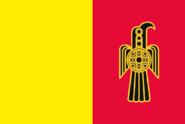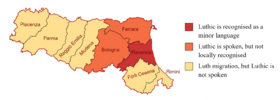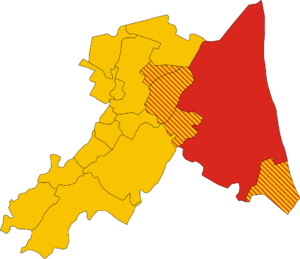Luthic
| Luthic | |
|---|---|
| Lûthica | |
 Flag of the Luthic-speaking Ravenna | |
| Pronunciation | [ˈlu.tʰi.xɐ] |
| Created by | Lëtzelúcia |
| Date | 2023 |
| Native to | Ravenna; Ferrara and Bologna |
| Ethnicity | Luths |
| Native speakers | 149,500 (2020) |
Indo-European
| |
| Official status | |
Recognised minority language in | Italy (recognised by the Luthic Community of Ravenna) |
| Regulated by | Council for the Luthic Language |
The areas where Luthic (red and orange) is spoken. | |
Luthic (/ˈluːθ.ɪk/ LOOTH-ik, less often /ˈlʌθ.ɪk/ LUTH-ik, also Luthish; endonym: Lûthica [ˈlu.tʰi.xɐ] or Rasda Lûthica [ˈʁaz.dɐ ˈlu.tʰi.xɐ]) is an Italic language that is spoken by the Luths, with strong East Germanic influence. Unlike other Romance languages, such as Portuguese, Spanish, Catalan, Occitan and French, Luthic has a large inherited vocabulary from East Germanic, instead of only proper names that survived in historical accounts, and loanwords. About 250,000 people speak Luthic worldwide.
Luthic is the result of a prolonged contact among members of both regions after the Gothic raids towards the Roman Empire began, together with the later West Germanic merchants’ travels to and from the Western Roman Empire. These connections and the conquest by the Germanic tribes of the Roman Empire slowly formed a creole for mutual communication.
As a standard form of the Gotho-Romance language, Luthic has similarities with other Italo-Dalmatian languages, Western Romance languages and Sardinian. The status of Luthic as the regional language of Ravenna and the existence there of a regulatory body have removed Luthic, at least in part, from the domain of Standard Italian, its traditional Dachsprache. It is also related to the Florentine dialect spoken by the Italians in the Italian city of Florence and its immediate surroundings.
Luthic is an inflected fusional language, with four cases for nouns, pronouns, and adjectives (nominative, accusative, genitive, dative); three genders (masculine, feminine, neuter); and two numbers (singular, plural).
Classification
Luthic is an Indo-European language that belongs to the Gotho-Romance group of the Italic languages, however Luthic has great Germanic influence; where the Germanic languages are traditionally subdivided into three branches: North Germanic, East Germanic, and West Germanic. The first of these branches survives in modern Danish, Swedish, Norwegian, Elfdalian, Faroese, and Icelandic, all of which are descended from Old Norse. The East Germanic languages are now extinct, and Gothic is the only language in this branch which survives in written texts; Luthic is the only surviving Indo-European language with extensive East Germanic derived vocabulary. The West Germanic languages, however, have undergone extensive dialectal subdivision and are now represented in modern languages such as English, German, Dutch, Yiddish, Afrikaans, and others.
Among the Romance languages, its classification has always been controversial, for example, it is one of the Italo-Dalmatian languages and most closely related to Istriot on the one hand and Tuscan-Italian on the other. Some authors include it among the [[w:Gallo-Italic languages|Gallo-Italic languages], and according to others, it is not related to either one. Although both Ethnologue and Glottolog group Luthic into a new language group, the Gotho-Romance (opere citato) family is still somewhat dubious.
Luthic has been influenced by Italian, Frankish, Gothic and Langobardic since its first attestation, the great influence of these languages on the vocabulary and grammar of Modern Luthic is widely acknowledged. Most specialists in language contact do consider Luthic to be a true mixed language. Luthic is classified as a Romance langauge because it shares innovations with other Romance languages such as Italian, French and Spanish.
History
The Luthic philologist Aþalphonso Silva divided the history of Luthic into a period from 500 AD to 1740 to be "Mediaeval Luthic", which he subdivided into “Gothic Luthic” (500–1100), “Mediaeval Luthic” (1100–1600) and “late Mediaeval Luthic” (1600–1740).
Gothic Luthic
The earliest varieties of a Luthic language, collectively known as Gothic Luthic or “Gotho-Luthic”, evolved from the contact of Latin dialects and East Germanic languages. A considerable amount of East Germanic vocabulary was incorporated into Luthic over some five centuries. Approximately 1,200 uncompounded Luthic words are derived from Gothic and ultimately from Proto-Indo-European. Of these 1,200, 700 are nouns, 300 are verbs and 200 are adjectives. Luthic has also absorbed many loanwords, most of which were borrowed from West Germanic languages of the Early Middle Ages.
Only a few documents in Gothic Luthic have survived – not enough for a complete reconstruction of the language. Most Gothic Luthic-language sources are translations or glosses of other languages (namely, Greek and Latin), so foreign linguistic elements most certainly influenced the texts. Nevertheless, Gothic Luthic was probably very close to Gothic (it is known primarily from the Codex Argenteus, a 6th-century copy of a 4th-century Bible translation, and is the only East Germanic language with a sizeable text corpus). These are the primary sources:
- Codex Luthicus (Ravenna), two parts: 87 leaves
- It contains scattered passages from the New Testament (including parts of the gospels and the Epistles), from the Old Testament (Nehemiah), and some commentaries. The text likely had been somewhat modified by copyists. It was written using the Gothic alphabet, an alphabet used for writing the Gothic language. It was developed in the 4th century AD by Ulfilas (or Wulfila), a Gothic preacher of Cappadocian Greek descent, for the purpose of translating the Bible.
- Codex Ravennas (Ravenna), four parts: 140 leaves
- A Civil code enacted under Theodoric the Great. The code covered the Ostrogothic Kingdom of Italy, but mainly Ravenna, as Theodoric devoted most of his architectural attention to his capital, Ravenna. Codex Ravennas was also written using the Gothic alphabet. The text likely had been somewhat modified by copyists. Together with four leaves, fragments of Romans 11–15 (a Luthic–Latin diglot).
Mediaeval Luthic
In the mediaeval period, Luthic emerged as a separate language from Gothic. The main written language was Latin, and the few Luthic-language texts preserved from this period are written in the Latin alphabet. From the 7th to the 16th centuries, Mediaeval Luthic gradually transformed through language contact with Old Italian, Langobardic and Frankish. During the Carolingian Empire (773–774), Charles conquered the Lombards and thus included northern Italy in his sphere of influence. He renewed the Vatican donation and the promise to the papacy of continued Frankish protection. Frankish was very strong, until Louis’ eldest surviving son Lothair I became Emperor in name but de facto only the ruler of the Middle Frankish Kingdom.

Late Mediaeval Luthic
Following the first Bible translation, the development of Luthic as a written language, as a language of religion, administration, and public discourse accelerated. In the second half of the 17th century, grammarians elaborated grammars of Luthic, first among them Þiudareico Bianchi’s 1657 Latin grammar De studio linguæ luthicæ.
De Studio Linguæ Luthicæ
De Studio Linguæ Luthicæ (English: On Study of the Luthic Language) often referred to as simply the Luthicæ (/lʌˈθiˌki, lʌθˈaɪˌki/), is a book by Þiudareico Bianchi that expounds Luthic grammar. The Luthicæ is written in Latin and comprises two volumes, and was first published on 9 September 1657.
Book 1, De grammatica
Book 1, subtitled De grammatica (On grammar) concerns fundamental grammar features present in Luthic. It opens a collection of examples and Luthic–Latin diglot lemmata.
Book 2, De orthographia
Book 2, subtitled De orthographia (On orthography), is an exposition of the many vernacular orthographies Luthic had, and eventual suggestions for a universal orthography.
Geographical distribution
Luthic is spoken mainly in Emilia-Romagna, Italy, where it is primarily spoken in Ravenna and its adjacent communes. Although Luthic is spoken almost exclusively in Emilia-Romagna, it has also been spoken outside of Italy. Luth and general Italian emigrant communities (the largest of which are to be found in the Americas) sometimes employ Luthic as their primary language. The largest concentrations of Luthic speakers are found in the provinces of Ravenna, Ferrara and Bologna (Metropolitan City of Bologna). The people of Ravenna live in tetraglossia, as Romagnol, Emilian and Italian are spoken in those provinces alongside Luthic.
According to a census by ISTAT (The Italian National Institute of Statistics), Luthic is spoken by an estimated 250,000 people, however only 149,500 are considered de facto natives, and approximately 50,000 are monolinguals.
Status
As in most European countries, the minority languages are defined by legislation or constitutional documents and afforded some form of official support. In 1992, the Council of Europe adopted the European Charter for Regional or Minority Languages to protect and promote historical regional and minority languages in Europe.
Luthic is regulated by the Council for the Luthic Language (Luthic: Gafaurdo faul·la Rasda Lûthica [ɡɐˈfɔɾ.du fɔl‿lɐ ˈʁaz.dɐ ˈlu.tʰi.xɐ]) and the Luthic Community of Ravenna (Luthic: Gamainescape Lûthica Ravennai [ɡɐˌmɛ.neˈska.fe ˈlu.tʰi.xɐ ʁɐˈvẽ.nɛ]). The existence of a regulatory body has removed Luthic, at least in part, from the domain of Standard Italian, its traditional Dachsprache, Luthic was considered an Italian dialect like many others until about World War II, but then it underwent ausbau.
Luthic regarded as an Italian dialect
Luthic lexicon is discrepant from those of other Romance languages, since most of the words present in Modern Luthic are ultimately of Germanic origin. The lexical differentiation was a big factor for the creation of an independent regulatory body. There were many attempts to assimilate Luthic into the Italian dialect continuum, as in recent centuries, the intermediate dialects between the major Romance languages have been moving toward extinction, as their speakers have switched to varieties closer to the more prestigious national standards. That has been most notable in France, owing to the French government’s refusal to recognise minority languages. For many decades since Italy’s unification, the attitude of the French government towards the ethnolinguistic minorities was copied by the Italian government. A movement called “Italianised Luthic Movement” (Luthic: Movimento Lûthicai Italianegiatai; Italian: Movimento per il Lutico Italianeggiato) tried to italianase Luthic’s vocabulary and reduce the inherited Germanic vocabulary, in order to assimilate Luthic as an Italian derived language; modern Luthic orthography was affected by this movement.
Almost all of the Romance languages spoken in Italy are native to the area in which they are spoken. Apart from Standard Italian, these languages are often referred to as dialetti “dialects”, both colloquially and in scholarly usage; however, the term may coexist with other labels like “minority languages” or “vernaculars” for some of them. Italian was first declared to be Italy's official language during the Fascist period, more specifically through the R.D.l., adopted on 15 October 1925, with the name of Sull'Obbligo della lingua italiana in tutti gli uffici giudiziari del Regno, salvo le eccezioni stabilite nei trattati internazionali per la città di Fiume. According to UNESCO's Atlas of the World's Languages in Danger, there are 31 endangered languages in Italy.





